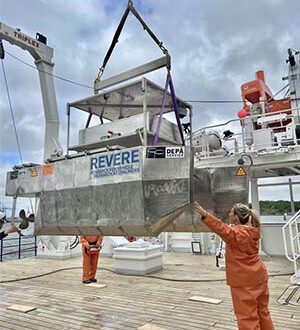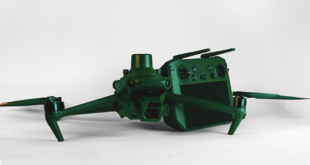In recent years, thousands of refugees and migrants have fled across the seas as a result of humanitarian crises around the world. A team from Chalmers University of Technology, Sweden, is now developing a fully autonomous drone system that can increase the efficiency and speed of response in rescue operations at sea. In the context of refugee crises and migratory flows, the sea has been a recurrent and risky route. Travelling on fragile or overloaded vessels has led to people losing their lives at sea. In the project ‘Quadcopter, fixed-wing and marine drones for search and rescue’, a team at Chalmers is developing a new kind of fully automated system for search and rescue operations. The system relies on water and air-based drones working together, using a communication system to independently search an area, alert authorities to people in distress and provide basic assistance before crewed rescue vehicles have arrived.
Drone systems working together have the potential to save more lives
The drone system consists of three components working together: a marine catamaran drone called Seacat, which serves as a base for the other drones, a fleet of winged aerial drones that monitor the surrounding area, and a quadcopter that can approach people in distress and deliver items such as supplies, healthcare aids or flotation devices. The quadcopter – a drone that has four engines and therefore the ability to hover – can carry loads weighing up to about two kilograms.
“The project is based on the simple principle that different drones have different advantages, and by allowing several different types of autonomous drones to work together, search efficiency and rescue response speed can be significantly improved, with the potential to save more lives,” says Xin Zhao, post-doc in the Fluid Mechanics Division at Chalmers.
Tomas Grönstedt, Professor in the Fluid Dynamics Division, says:
“In addition, the system could – in principle – be linked to any public service or to volunteers who could provide some form of assistance.”
Automatic battery charging and launching the next stage
The marine drone, Seacat, provides an internet uplink as well as a local communication link that is used to coordinate the flying drones. It also includes a launch pad for the fixed-wing drones. All airborne drones are equipped with cameras and a positioning system. All drones can move fully autonomously – the marine drone follows a predefined route with a closed loop. Fixed-wing drones are automatically assigned to search areas according to an intelligent algorithm that makes best use of the number of drones available. When a fixed-wing drone detects objects in the water, the quadcopter is sent to the scene to take pictures. The photographs can then be sent to a rescue centre on land via the marine drone. The rescue centre, for its part, can send out the quadcopter with supplies. When one of the winged drones runs out of battery, it is taken out of service and lands in the water near the Seacat drone, where it can be picked up and recharged automatically, and then sent out again.
‘”So far, we have succeeded in carrying out a quadcopter landing on Seacat, and the winged drones have been built and are in the process of being assessed,” says Ola Benderius, Associate Professor in the Vehicle Engineering and Autonomous Systems Division, who has also led the project.
‘”As part of a continuation of the project, we will put the system together and test it in its entirety out at sea.”
More about the project
The drone system has been developed in collaboration between the Vehicle Mechanics and Autonomous Systems Division and the Fluid Dynamics Division of the Department of Mechanics and Maritime Sciences.
The marine drone and the winged drones are designed from scratch, built and tested at Chalmers.
The team includes Tomas Grönstedt, Xin Zhao, Isak Jonsson and Carlos Xisto from the Fluid Dynamics Division, Ola Benderius from the Vehicle Mechanics and Autonomous Systems Division of the Department of Mechanics and Maritime Sciences, Leif Eriksson from the Earth Sciences and Remote Sensing Division of the Department of Space, Earth and Environment and Christian Berger from the Software Engineering Division of the Department of Computer Science and Engineering.
The project is being run within Chalmers’ research infrastructure Revere, with funding from the Transport Area of Advance. The project will come to an end in September 2022.
 Unmanned Aerial Vehicle The latest drone news
Unmanned Aerial Vehicle The latest drone news



